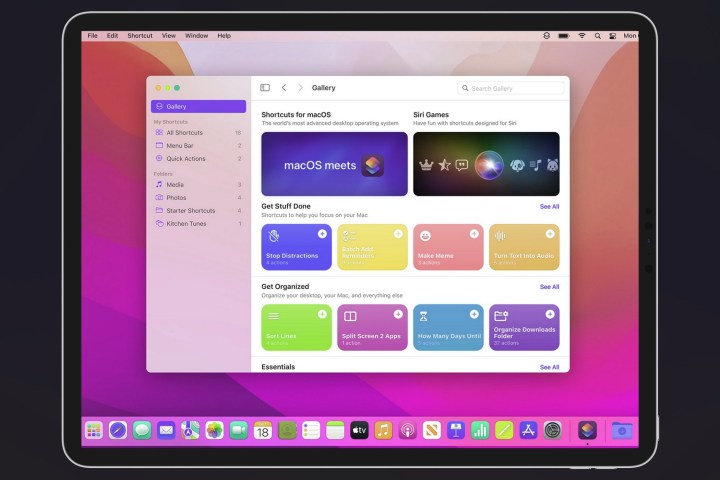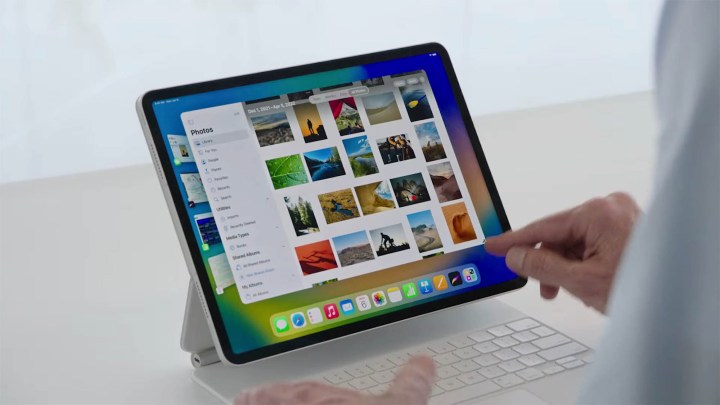Just over a year ago, Apple announced the next-gen iPad Pro packing the same M1 silicon as its computing brethren in the Mac lineup. With the move, Apple took a massive lead in the tablet ecosystem, redefining what that form factor can accomplish. But as they say, with great power comes great responsibility. No sooner than the device was announced, fans started questioning whether it was overkill or just a future-proof move.
The latter doesn’t seem to be the case here, as Apple has already launched the successor with the new M2 chip inside. A small faction of Apple watchers, however, speculated that with an M-series chip inside the iPad, Apple might eventually port the macOS experience to its Pro tablets. Well, it looks like Apple is at least experimenting with the idea.
According with my source Apple would be testing a smaller version of macOS exclusively for the new iPad Pro M2!
"Mendocino" should be the codename for macOS 14. A simplified version should be planned for the M2. pic.twitter.com/f4RrainlZ1— Majin Bu (@MajinBuOfficial) October 20, 2022
Leakster @MajinBuOfficial claims that Apple will soon start testing a “smaller version of macOS exclusively for the new iPad Pro M2.” This simplified version of the Mac operating system, which succeeds macOS Ventura, will target tablets with the M2 silicon inside.
The hardware stage is set
Now, take this “leak” with the most generous dose of skepticism that you can muster. Of course, the idea is ambitious and almost like a dream come true for folks hoping for a Microsoft Surface-like device in the iPad’s shell — running macOS instead of iPadOS. Plus, this isn’t the first time we are hearing such a rumor.
But maybe, just maybe, Apple is finally confident enough in the prowess of its M-series silicon that it is willing to test a watered-down version of macOS that will offer at least a semblance of true computing on the iPad. After all, the iPad Pro has all the power and a pretty capable keyboard to go with it. Moreover, with Apple Pencil support, it even surpasses the humbled MacBook in terms of interaction versatility.

The biggest argument in favor of macOS happening natively on the iPad Pro? Well, it uses the same M-series processor as the MacBook. Heck, Apple has even matched the RAM and storage standards. Take, for example, the M2 iPad Pro — which packs in a Macbook-grade 16GB of unified memory and up to 2TB of storage. Plus, if the fan-less MacBook Air is anything to go by, Apple’s engineers won’t have to lose much sleep over thermal if – and that’s a big IF – macOS eventually comes to the iPad.
There are multiple ways in which Apple can hypothetically port over macOS – or a macOS-like – experience to the M2 iPad Pro. Starting with the least unlikely scenario, Apple might be open to the idea of a dual-OS booting system. But given the company’s public disdain for ecosystem openness, we can safely relegate that to a dreamy wishlist.
There are a few possibilities
Moving to the more likely side of things, Apple might cook up something like Samsung’s DeX mode for iPadOS. Enabling this imaginary feature would essentially launch an iPadOS overlay that looks and feels like macOS. How deep the customizations run will eventually decide the final quality.
But hey, we live in the era of fast mmWave 5G internet and blazing-fast broadband internet, which has turned something as improbable as cloud gaming into a huge market. With all that progress in cloud computing and internet infrastructure, we have also entered the era of leasing cloud-based computers that you can carry and access anywhere.

Take Microsoft’s Windows 365 Cloud PC service, which lets you run a cloud-based desktop computer on any other Windows, Android, macOS, and iOS device — just as long as you have a fast internet connection. Interestingly, Amazon already offers a “Mac Mini as a service” product called Amazon EC2 Mac instances that lets you access an M1 Mac mini in the cloud. It isn’t hard to imagine Apple offering a similar service for the iPad.
Then there’s always the emulation route. Windows PC users have been reaping the benefits of Android for years using the free Bluestacks emulation software. With the M2 iPad Pro, Apple doesn’t even have to grapple with architecture hassles, as macOS should run very well natively on the ARM-based silicon inside the iPad, albeit with a healthy dose of optimization that could take some time.
The bitter bite of reality
But even with shared hardware genes, bringing macOS features to the iPad won’t be a cakewalk. Unless Apple wants to pure-boot macOS on the iPad, replicating the macOS experience would be tricky while using iPadOS as the software foundation. The best example? Our beloved Stage Manager, which is supposed to bring a Mac-like multitasking experience to the iPads.

Following a well-publicized compatibility fiasco and the company eventually giving up, the feature received a ton of flak for being half-baked and buggy as hell during the beta-testing phase. It’s no wonder that Apple decided to delay it, and is now aiming to release it with the iPadOS 16.1 build that will likely start rolling out when the new iPads hit the shelves.
Maybe, macOS running on iPads is Apple’s way of finally offering a Mac with touchscreen convenience. As lofty as all that sounds, Apple will likely never bring the full-blown macOS experience to iPads. It isn’t hard to imagine why. To begin with, Apple wouldn’t want a macOS-running iPad Pro to eat into the sales of MacBooks.
Both the Mac and iPad lines are businesses worth billions of dollars each, and it just wouldn’t make sense for Apple to take such a risk. After all, this is the same company that is dreaming of reviving a 2017-era iPhone XR chassis for a budget phone that is slated to arrive next year, or early 2024.
Plus, Apple has spent a healthy amount of time, and resources, polishing iPadOS. It makes little sense for Apple to relegate it to the sidelines anytime soon. So, what’s next? Well, the best we can do is take the latest leak as an ambitious rumor at best. If it happens, I’ll be ready with my money. If it doesn’t, life will go on, because this is Apple we’re talking about, after all!
Editors' Recommendations
- This hidden iPad Pro Easter egg is unbelievably cool
- The new iPad Pro just surprised everyone
- iOS 17.5 just launched with a huge security feature for your iPhone
- Apple’s new iPad Pro keyboard is a bigger deal than you think
- Apple finally fixed my biggest issue with the iPad Pro



